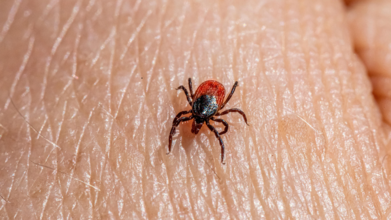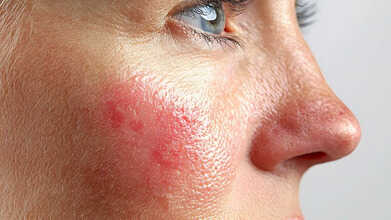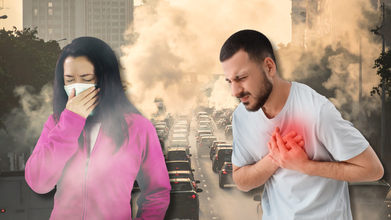- Health Conditions A-Z
- Health & Wellness
- Nutrition
- Fitness
- Health News
- Ayurveda
- Videos
- Medicine A-Z
- Parenting
- Web Stories
What Is Babesia That Could Block Your Lyme Disease Recovery?

Credits: Canva
Lyme disease is often described as a medical puzzle. Many patients expect recovery after treatment, but for some, lingering symptoms like fatigue, sweats, palpitations, or breathing difficulties, continue to disrupt daily life. Increasingly, researchers and practitioners are recognizing that a hidden co-infection may be responsible: Babesia.
Though transmitted by the same ticks that spread Lyme disease, Babesia is a parasite rather than a bacterium. This means that while standard antibiotics for Lyme may clear Borrelia burgdorferi (the Lyme-causing bacteria), they do not affect Babesia. If left untreated, the infection can stall or even derail recovery.
What Is Babesia?
Alexis Chesney, MS, ND, LAc, who is also a naturopathic physician, acupuncturist, author, and educator specializing in Lyme and vector-borne disease, writes that Babesia is a malaria-like parasite that invades red blood cells, belonging to the phylum Apicomplexa.
Also Read: Ebola Outbreak Update: Vaccines Continue To Arrive As Congo Yet Again Becomes Disease Hotspot
First described in the late 19th century, it has since been identified in multiple species, with Babesia microti and Babesia duncani being most common in the U.S. The Centers for Disease Control and Prevention (CDC) recently reported a rise in cases across the Northeast and upper Midwest, even declaring Vermont, New Hampshire, and Maine as endemic states.
The parasite is transmitted by the blacklegged tick (Ixodes scapularis) in the East and Midwest, and Ixodes pacificus in the West. Transmission can occur within 36 hours of tick attachment, making timely removal critical.
How Babesia Blocks Lyme Recovery
Lyme disease is caused by bacteria, while Babesia is a protozoan parasite. The difference is crucial: antibiotics like doxycycline or ceftriaxone, typically prescribed for Lyme, have no effect on Babesia. When this parasitic infection is overlooked, patients often remain sick despite completing Lyme treatment.
This overlap of infections is common in regions where both pathogens circulate. Patients coinfected with Babesia and Lyme may experience a tougher, more prolonged illness, with night sweats, air hunger (difficulty breathing at rest), and palpitations serving as hallmark clues that Lyme alone isn’t to blame.
Symptoms to Watch
Babesia symptoms can vary widely, from mild to life-threatening. Common complaints include:
- Excessive sweating or night sweats
- Crushing fatigue
- Shortness of breath or “air hunger”
- Heart palpitations or chest pain
- Headaches and joint aches
In severe cases, particularly in older adults, immunocompromised individuals, or those without a spleen, Babesia may cause hemolytic anemia, kidney problems, and organ stress.
Diagnosis
Because symptoms overlap with Lyme disease, Babesia often goes undiagnosed without specific testing. Traditional options include:
Blood smear (Giemsa-stained): A classic but limited method, as only a tiny fraction of red blood cells may show parasites in early or chronic cases.
PCR testing: Detects Babesia DNA with high sensitivity in acute infections.
FISH (fluorescence in situ hybridization): A more advanced method that detects Babesia RNA, distinguishing between live and dead parasites and proving especially valuable in chronic disease.
Accurate testing is critical, as untreated Babesia can persist and block progress against Lyme.
Treatment Approaches
Conventional treatment generally involves a combination of atovaquone and azithromycin for 7–10 days in mild to moderate cases. More severe or persistent infections may require longer regimens, sometimes with alternative drugs like clindamycin and quinine. However, treatment failures and drug resistance have been reported.
Naturopathic and integrative therapies are increasingly used alongside pharmaceuticals. Herbs such as Cryptolepis sanguinolenta, Artemisia annua (Sweet Annie), Polygonum cuspidatum (Japanese Knotweed), and Scutellaria baicalensis (Chinese skullcap) have shown anti-Babesia activity in laboratory studies. These botanicals not only target parasites but also support the immune system, reduce inflammation, and protect red blood cells.
Some practitioners also use anti-biofilm agents like serrapeptase or lumbrokinase to break down protective barriers that Babesia forms, making antimicrobial treatment more effective.
Why Awareness Matters
As Babesia spreads to new geographic regions, it is critical for healthcare providers to recognize its role in chronic illness. Ignoring Babesia may leave patients trapped in a cycle of incomplete Lyme recovery, chasing symptoms without lasting relief. A thorough approach that screens for co-infections and treats them comprehensively is essential.
For patients struggling with ongoing fatigue, sweats, or unexplained heart and lung symptoms after Lyme treatment, the missing piece could be Babesia. Recognizing and addressing this stealth parasite may be the key to finally breaking through to recovery.
Can A Rash Be A Sign Of COVID-19? Here’s Everything You Should Know

Credits: canva
When COVID-19 first emerged, it was largely seen as a respiratory illness. Over time, doctors discovered that the virus can affect nearly every major organ, including the heart, kidneys, liver, and skin. While cough, fever, and fatigue remain common signs, some people also develop unusual skin reactions. So, can COVID-19 actually lead to rashes? Here’s what experts have found.
Can COVID-19 Really Cause Rashes?
When COVID-19 first emerged, it was largely seen as a respiratory illness. Over time, doctors discovered that the virus can affect nearly every major organ, including the heart, kidneys, liver, and skin. While cough, fever, and fatigue remain common signs, some people also develop unusual skin reactions. So, can COVID-19 actually lead to rashes? Here’s what experts have found.
What Do COVID-19 Rashes Look Like?
Skin changes linked to COVID-19 are not among the most common symptoms, but they do occur. These rashes may appear on the neck, mouth, or toes and are often caused by inflammation in the body, as per Health website. They can look like flat or raised patches, small round spots, or itchy bumps. In some people, these rashes appear while they’re infected; in others, they show up weeks later.
Why Do These Rashes Occur?
Researchers believe COVID-related rashes are connected to how the virus interacts with the body’s ACE2 receptors, which are found in the skin. When the virus attaches to these receptors, it can trigger the release of inflammatory proteins called cytokines. This inflammation may lead to skin irritation, itchiness, or lesions.
Common Types of COVID-19 Rashes
1. COVID Toes
One of the most recognized skin signs of the virus, “COVID toes,” resembles chilblains, which are cold-weather sores. They appear as pink, red, or purple patches, sometimes with swelling or blistering. This condition is seen more often in younger people and may occur even after other symptoms fade.
2. Hives (Urticaria)
Hives tend to appear suddenly and can spread across any part of the body. They’re itchy, raised, and may come and go within hours or days.
3. Neck Eczema
Some people develop eczema-like rashes on the neck, chest, or trunk during or after COVID-19. The patches can be itchy and vary in color depending on skin tone—pink on lighter skin and brown, gray, or purple on darker skin.
4. Oral Rash
COVID can also cause soreness or peeling inside the mouth or on the lips. The area may feel dry, irritated, or scaly as it heals.
5. Vesicular and Papular Rash
These small, itchy bumps can be filled with fluid (vesicular) or solid (papular). They may appear anywhere on the body and are often linked with ongoing inflammation.
6. Pityriasis Rosea
This condition begins with a single large patch on the chest, back, or abdomen, followed by smaller spots that form a tree-like pattern. Though harmless, it can take several weeks or months to fade.
7. Purpuric or Vasculitic Rash
These rashes appear as dark, bruise-like spots caused by small blood vessel damage under the skin. The color may range from red and purple to brown or black, depending on skin tone.
How Long Do COVID Rashes Last?
The duration depends on the type of rash and the person’s immune response. Most clear up within 2 to 12 days, but some, especially in long COVID cases, may persist for weeks.
How Are COVID Rashes Treated?
Many rashes resolve without any special treatment. To relieve itching or pain, applying mild hydrocortisone cream can help. For more severe or persistent cases, doctors may recommend:
- Antihistamines to reduce itching
- Corticosteroids to lower inflammation
- Blood thinners if the rash is linked to blood vessel irritation
Your doctor will determine the safest treatment depending on the type of rash and overall health.
Disclaimer: This article is for general informational purposes only and should not be considered medical advice. Always consult a qualified healthcare professional before starting, stopping, or changing any medication, or if you experience any unusual symptoms or side effects.
Don't Ignore Your 'Winter Blues', This Is The Biological Reason Behind Winter Depression

(Credit-Canva)
It is a common theme for people to feel down and sad in winter. However, why do shorter, colder days often bring on feelings of loneliness and gloom? There is a biological reason behind it. As the days get shorter, many people feel a dip in energy or mood, but for millions, this signals Seasonal Affective Disorder (SAD), which is a serious form of depression that shouldn't be ignored. Experts from West Virginia University (WVU) caution that SAD symptoms are very similar to major depressive disorder and must be taken seriously.
What Causes SAD?
SAD is much more than just feeling down when it gets dark. It's a genuine type of depression most often seen during the winter months, especially in places far north where daylight is scarce. The basic problem is simple: less natural light hits your eyes. This drop in sunlight confuses your brain's chemistry.
It messes with two vital brain chemicals: serotonin, which helps stabilize your mood, and melatonin, which controls when you sleep and wake up. This lack of light also throws off your body's internal clock, called the circadian rhythm. When all these elements get disrupted, it triggers feelings of low energy and depression.
What Are The Symptoms Of SAD?
SAD involves a cluster of symptoms that persist and significantly interfere with your daily life. The pattern is usually predictable: symptoms begin in the fall, peak in the winter, and disappear by spring. Symptoms often include:
- Feelings of hopelessness.
- Loss of interest in activities you once enjoyed.
- Significant changes in sleep (often sleeping more, or having disrupted sleep).
- Changes in appetite or increased food cravings.
- Difficulty concentrating and persistent fatigue.
The risk of SAD is higher among younger people, women, and those with a family history of mood disorders.
Can You Treat/Prevent Seasonal Affective Disorder?
Because Seasonal Affective Disorder is highly predictable, experts advise starting preventative treatments early in the fall. Seeing a healthcare provider is essential to determine the best plan and timing for treatment, rather than waiting for severe symptoms to appear later in winter.
Light Therapy
This involves sitting daily before a special light box emitting 10,000 lux of bright white light. Doing this for 30 to 60 minutes each morning is the most common and effective treatment for SAD, as it helps correct the imbalance caused by reduced sunlight exposure.
Cognitive-Behavioral Therapy (CBT)
This form of talk therapy teaches you practical skills to manage negative thinking patterns and behaviors linked to depression. CBT helps individuals reframe their outlook on winter and build effective coping mechanisms to reduce the impact of SAD symptoms.
Medication
In certain situations, a healthcare provider may prescribe antidepressant medication to help regulate mood-affecting brain chemicals like serotonin. This is often considered alongside light therapy or counseling, especially if symptoms of depression are severe or persistent.
Lifestyle Changes
Simple daily habits are powerful tools. Regular exercise boosts mood and energy, while maintaining a consistent sleep schedule keeps your body's internal clock stable. These practical steps offer significant support alongside clinical treatments.
Delhi's 'Very Poor' AQI Will Get Worse In The Next Few Days: What Organs Are Being Impacted The Most?

(Credit-Canva)
Delhi’s air quality has taken a severe turn for the worse. As of Monday morning, November 3, 2025, the air across the capital officially slipped into the "Very Poor" category. Government data shows that the Air Quality Index (AQI) hit 316 by 9 am, meaning the air is now considered a significant health risk. In fact, one private monitor estimates that breathing the air in Delhi is currently as harmful as smoking 7.8 cigarettes a day.
Researchers and healthcare professionals have explained how pollution not only affects our breathing and lung function, but it affects multiple organs. A 2024 study published in the Scientific Reports journal showed that PM2.5 pollution particles are linked with reduction in life expectancy by 3.7 years.
However, when it comes to organ functions, pollution affects different organs differently. Here’s how.
Why Does Pollution Affect Our Organ Health?
According to the World Health Organization (WHO), air pollution is when the air contains one or more harmful substances like dust, smoke, fumes, or gas for a long time as they hurt our health.
The main way these pollutants affect us is by being breathed in. When you inhale them, they cause damage throughout your body, leading to:
- Inflammation (swelling)
- Stress on your cells
- A weaker immune system
- Changes to your cells that can cause disease (mutagenicity)
What Organs Are Affected By Pollution?
Here is a list of organs that you may not know were affected by pollution.
Brain and Mind
According to UC Davis Environmental Health Sciences Center, these pollutants are small they can travel from your lungs directly into your brain. This toxic exposure is concerning for long-term brain health. It's been linked to a higher risk of developing severe conditions like dementia and Alzheimer’s disease. It may also impact children, potentially affecting intelligence, and increasing the risk of disorders like autism. Research also shows a higher risk of stroke, depression, and anxiety disorders.
Air pollution doesn't just cause disease; it can also cause more immediate, subtle effects on healthy people, which is often called "brain fog" decreased productivity or trouble thinking clearly. Studies across various jobs, from farm workers to office workers—show that short bursts of high outdoor pollution lead to decreased work output.
Heart and Lungs
According to the WHO, the lungs are hit first, leading to immediate problems like asthma and long-term illnesses like lung cancer or emphysema. Once in the bloodstream, the particles tighten your blood vessels (arteries), which forces the heart to work much harder. This sharply increases your risk for life-threatening events like strokes and heart disease.
Skin
The Airly organization explains that your skin is naturally covered in a layer of helpful bacteria, fungi, and viruses—called the microbiome. Air pollutants (like smog) disrupt the size and variety of this helpful microbiome. When this balance is broken, harmful bacteria can grow out of control.
Being the body’s largest organ and completely exposed, shows damage from air pollution through signs like faster aging, more wrinkles, and rashes. Surprisingly, the internal effects go deeper: prolonged exposure to harmful chemicals found in pollution, such as PAHs and ozone, you face an increased risk of developing skin cancer.
Bone
According to a 2024 study published in the Current Osteoporosis Reports, growing evidence shows a link between air pollution and a higher risk of osteoporosis, a disease that makes bones weak. This is a major concern for our aging population, as severe bone fractures greatly increase death risk. While we don't know the exact pollutants or how they cause this, initial research suggests inflammation from dirty air may damage the bones. Identifying this pathway could lead to new treatments.
Kidney
According to the National Kidney Foundation, pollution adds a major toxic burden to your body's internal cleaning crew. A study of 2.5 million U.S. veterans found that breathing polluted air significantly increases the risk of developing kidney disease. The scientists estimated that over the course of the study, air pollution may have caused roughly 45,000 new cases of chronic kidney disease (CKD) and forced over 2,400 patients to start dialysis.
While the exact way air pollution damages the kidneys is still unknown, one main idea is that the tiny pollution particles you inhale travel from your lungs into your bloodstream. The kidneys then try to filter this contaminated blood, and in the process, the tiny particles directly damage the kidney cells.
Reproductive System
According to the Journal of Obstetrics and Gynecology of India pregnant people, pollution exposure increases the likelihood of miscarriages and can harm the developing baby, leading to health issues in unborn and newborn children. It threatens the future health of the population.
When a pregnant woman is exposed to pollutants, it causes an inflammatory reaction that can harm the pregnancy. This toxic exposure is linked to serious problems, including preterm labor, fetal growth restriction, death of the baby before or during birth.
Studies confirm that inhaling tiny pollution particles (PM) and nanoparticles (NP) causes excessive cell damage, leading to mutations in DNA and damage to fats and proteins in the body.
Digestive Health
According to the Northwell Health Organization, new research suggests that the tiny particles found in it contribute to digestive illnesses.
Exposure to pollution also stresses your body. This chronic, pollution-induced stress leads to an overload of inflammation and cell damage (oxidative stress) in the digestive system. This can contribute to common conditions like Irritable Bowel Syndrome (IBS), Inflammatory Bowel Disease (IBD), Gastroesophageal Reflux Disease (GERD).
Breathing in things like fine particles, fumes, and gases can cause inflammation in the digestive tract. Long-term exposure to dirty air is linked to higher risks of GERD and IBD.
© 2024 Bennett, Coleman & Company Limited

